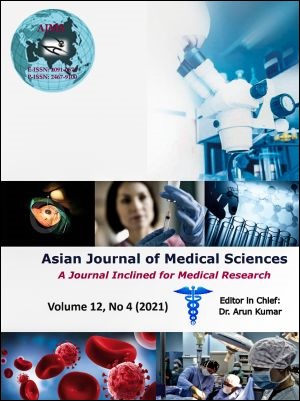Characterization of mandibular fractures on computed tomography
Keywords:
Communited fractures, Computerized tomography, Traffic accidents, Facial injuriesAbstract
Background: With rapid urbanization and motorization of the society there is an exponential increase in road traffic accidents (RTA). Facial trauma and mandibular fractures are some of the common injuries seen in these cases. Imaging of these fractures is essential part of management. Panoramic and oblique X-rays can be used to diagnose these fractures however computerized tomography gives a unique advantage as it enables 3 D reconstructions of images. We conducted this study to assess the patterns of mandibular fractures and associated injuries presenting to a tertiary care center.
Aims and Objectives: The study was conducted to assess the patterns of mandibular fractures and associated injuries presenting to a tertiary care center in Aurangabad.
Materials and Methods: This was a prospective study in which 30 cases with complaints of facial trauma and with mandible fractures were included on the basis of a predefined inclusion and exclusion criteria. A detailed history was taken and mode of injury, duration since injury and history of any other trauma was noted down in proforma. Demographic details such as age and gender was also noted down. The CT scan of the face was done. Beam collimation of 2 mm, pitch of 1.2 mm and 120 Kv voltage was used. Patterns of mandibular fracture were analyzed.
Results: Out of 30 patients there were 27 (90%) males and 3 (10%) were females with a M:F ratio of 9:1.The mean age of male and female patients was found to be 34.96 +/- 10.49 years and 26.66 +/-5.90 years respectively. Road traffic accidents (RTA) were the predominant causative mechanism and was seen in 27 (90%) of cases. Unilateral multifocal fractures involving body of the mandible were the most common type of fractures. Body of the mandible was seen to have been fractured in 17 (56.66%) cases.
Conclusion: Mandibular fractures are commonly seen following road traffic accidents. Though X-Rays can be used for diagnosis of these fractures Computerized tomography gives a distinct advantage of ability to do 3-D reformatting of images.
Downloads
Downloads
Published
How to Cite
Issue
Section
License
Authors who publish with this journal agree to the following terms:
- The journal holds copyright and publishes the work under a Creative Commons CC-BY-NC license that permits use, distribution and reprduction in any medium, provided the original work is properly cited and is not used for commercial purposes. The journal should be recognised as the original publisher of this work.
- Authors are able to enter into separate, additional contractual arrangements for the non-exclusive distribution of the journal's published version of the work (e.g., post it to an institutional repository or publish it in a book), with an acknowledgement of its initial publication in this journal.
- Authors are permitted and encouraged to post their work online (e.g., in institutional repositories or on their website) prior to and during the submission process, as it can lead to productive exchanges, as well as earlier and greater citation of published work (See The Effect of Open Access).




